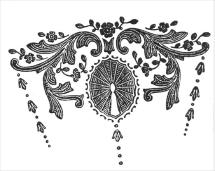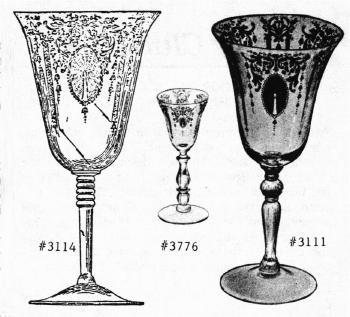Candlelight
by Mark Nye
Issue No. 126 - October 1983
"Modern table linens, china and silver require glassware that blends into the general motif of the new fashions. 'Candlelight' does that perfectly, it is modern without being modernistic and classic without being entirely Grecian…"
"A pattern of shimmering lights aglow along lace-like traceries distinguish this lovely and tasteful American hand-made etched crystal."
 Thus, we are introduced to the Candlelight etching thru quotes from
original Cambridge Glass Company advertising for the pattern. While
neither advertisement is dated I feel the former was written not later
than 1936 or 1937 and that the second quote is from the mid to late
1940s.
Thus, we are introduced to the Candlelight etching thru quotes from
original Cambridge Glass Company advertising for the pattern. While
neither advertisement is dated I feel the former was written not later
than 1936 or 1937 and that the second quote is from the mid to late
1940s.
It must be noted at the beginning - this article is about the Candlelight etching! Not too widely know is the fact that the Cambridge Glass Company also made a Candlelight rock crystal engraving. Little is known concerning this cutting - so, rather than confuse readers of this article, the information I do have regarding the cutting will be shared at a future date.
The plate etching known as Candlelight was created between mid 1934 and January 1936. It is not seen in the N.C.C. 1930-34 Catalog Reprint (the last pages of which were issued in early 1934). Candlelight does appear, in drawing form, on a patent for the #3114 stemware issued to W.C. McCartney on February 11, 1936. When the etching actually went into production is not yet known. A Candlelight advertisement showing photographs of etched pieces and including a trademark known to have been discontinued by the end of 1937 establishes that production occurred prior to 1938.
Production of Candlelight during the 1936-37 period is further confirmed by a picture of the #3400 dinnerware with this etching, that appeared in the book "Modern Fine Glass," written by Leloise Davis Skelley in 1937. (For more information regarding this book, refer to the April 1978 issue of the CRYSTAL BALL.)
The Cambridge Glass Company catalog, issued in January 1940, contained seven pages devoted to illustrations of the Candlelight etching. The price list that accompanied this catalog had 128 listings under Candlelight on Crystal, representing over 120 different pieces. This price list also included 99 listings under Decoration D/1048, etched Candlelight, Gold Encrusted. These too, all utilized crystal blanks.
The June 1949 section of the N.C.C. 1949-53 Catalog Reprint contained five pages of Candlelight, showing 56 different item numbers. Since the price list for this catalog is unavailable, it is not know if this represents all Candlelight being offered at that time. Some time after the original catalog was issued, a supplemental page, showing the etching on the #3776 stemware, was issued. With the addition of this stemware, the total number of pieces shown in the 1949-53 Catalog Reprint is 66.
The October 1953 price list makes no mention of Candlelight. Thus, as an active pattern, it must have been discontinued sometime between June 1949 and that date. During the re-open period, the etching was available on the #3776 stemware, for awhile, thru a replacement service for inactive patterns. The following, regarding this service, is quoted from the March 1956 price list,
"To further improve out service to our customers, we have inaugurated another CAMBRIDGE GLASS first by providing inactive listings. This means to you that you can assure your customers that they will always be able to obtain replacements for their fine CAMBRIDGE glassware patterns. In the regular course of business we shall accumulate your replacement orders over a period of time so that we may ship such orders at least twice a year. We shall be glad to quote you prices on inactive listings upon request. However, in view of the increased cost of producing small quantities of glass, you may reasonably expect prices of inactive patterns to run 20% to 25% higher than on similar active items. Please remember that inactive DOES NOT MEAN discontinued."
The final Cambridge price list, issued in 1958, makes no reference to the replacement service or to Candlelight. Thus, Candlelight appears to have been available for approximately a 20-year span (1936-37 to 1956-57). It remains somewhat of a mystery as to why more advertising material for this etching has not turned up. It must have sold well to have remained in the Cambridge line for so long. The question is, "How was it promoted?"
Another question about Candlelight is, "Where is it?" For a pattern that covered a 20-year period, relatively little is seen today! It is, by no means, considered rare. But, one would expect to see more, considering the amount that must have been made over the years.
This writer is not aware of Candlelight on colored blanks. This does not mean such was never produced. However, because of the time span involved, it is doubtful other than occasional pieces would have been made in color - and this probably would have occurred, if at all, before 1940.
 Candlelight was etched on three stemware lines: #3111, #3114 and
#3776. The #3111 and #3114 appear in the 1940 Cambridge Glass Company
catalog, with or without gold encrustation of the etching. The N.C.C.
1949-53 Catalog Reprint pictures #3111 and #3776 with the etching.
Through the patent for the #3114 stemware, we can conclude the etching
was probably first used on this line during 1936. Stemware #3111 also
dates to the mid 1930s and initial use of Candlelight on it no doubt
also occurred ca 1936-37. The #3776 stemware was introduced ca. 1941-42
and first use of this line with the Candlelight etching may have
occurred shortly thereafter.
Candlelight was etched on three stemware lines: #3111, #3114 and
#3776. The #3111 and #3114 appear in the 1940 Cambridge Glass Company
catalog, with or without gold encrustation of the etching. The N.C.C.
1949-53 Catalog Reprint pictures #3111 and #3776 with the etching.
Through the patent for the #3114 stemware, we can conclude the etching
was probably first used on this line during 1936. Stemware #3111 also
dates to the mid 1930s and initial use of Candlelight on it no doubt
also occurred ca 1936-37. The #3776 stemware was introduced ca. 1941-42
and first use of this line with the Candlelight etching may have
occurred shortly thereafter.
Several major Cambridge lines were, to varying degrees, the recipients of Candlelight with major emphasis on the #3400 line, during the late 1930s to mid 1940s. In the 1949-53 Catalog Reprint, the Corinth (#3900) line was the featured blank. Other lines used to a lesser extent with this etching include Tally-Ho, Gadroon and Pristine.
A ca. 1936-37 Candlelight advertising pamphlet contained illustrations of pieces from three of these line, the #3400, Gadroon and Tally-Ho. A reprint of this pamphlet accompanies this article.
The 1940 price list for candlelight lists from the #3400 line: the bread and butter, two salad plates (7½" and 8½") and the #3400/54 cup and saucer. However, there is no dinner plate listed. Earlier production of the #3400 line dinner cannot be ruled out at this time. There were numerous other items from this same line available with this etching, such as: sugar and creamer, #3400/161 oil bottle, bowls, handled plates, shakers and candelabrum. Of major interest to many collectors, and also available in 1940, is the Candlelight etched #3400/152 Doulton jug.
Six Gadroon blanks were being etched Candlelight in January 1940. In addition to the #57 three-compartment candy box and cover, there were four relish dishes, including the #112 15" oblong celery and relish and the #67 12" tray.
Tally-Ho etched Candlelight being offered in 1940 consisted entirely of three twin salad dressing bowls, #133, #137 and #95 and sets including these bowls. The sets were made up of bowl and ladles or bowl, ladles and underplate.
Pristine etched Candlelight from this period was limited to three items: #19 two-piece mayonnaise set; #99 cocktail shaker with chrome top; and the #187 two-piece grapefruit or salad icer.
Three styles of tumblers, in addition to those from the stemware lines and the 33400/115 were also being offered in 1940. These were the #498 in five sizes; the #397 in three sizes with shammed bottoms and the #321, also with shammed bottoms and in three sizes.
Other pieces being etched Candlelight during the early 1940s include the #1321 28 oz. footed decanter, #7966 2 oz. sherry, #1066 cigarette holder; #980 5" cheese dish and cover; miscellaneous bowls, plates, shakers and vases - seven of them, as a matter of fact!
Many of the pieces described or listed in the preceding paragraphs dealing with the 1940 availability of Candlelight, also came with the etching gold encrusted. These included a large number of the #3400 line items, excluding the cup and saucer, but including the Doulton jug, all of the Tally-Ho salad dressing bowls and sets; both stemware lines and all seven vases.
While not known in transparent colors, Candlelight was etched onto Crown Tuscan blanks and then gold encrusted. One could spend a lifetime attempting to put together a collection of the Candlelight crown Tuscan vases, for there are 15 of them to be found. Completing the 1940 listing of Crown Tuscan with Candlelight are three candlesticks, a bowl, the 12" Gadroon #3500/42 covered urn, a relish and the Gadroon #3500/57 candy box.
As mentioned earlier, the 1949-53 Catalog Reprint pictures Candlelight on two stemware lines, #3111 and #3776. Neither line, however, is shown in its entirety. The daiquiri cocktail and two of the footed tumblers (3 oz. and 10 oz.) are missing from the #3776 line illustration; while the #3111 line is lacking the claret, cordial and two footed tumblers, again the 3 oz. and 10 oz. sizes.
In addition to the pieces shown on the two pages from the 1949-53 Catalog Reprint (reprinted with this article), and the stemware, other items of Candlelight being offered in 1949 included no less than five relish dishes, two mayonnaise sets, three candlesticks and three four-footed bowl. Also available were the #3900/100 oil bottle, #3900/115 13 oz. tumbler, #3900/165 candy box and cover, #3900/117 shakers, and the #968 two-piece cocktail icer.
The failing fortunes of the Cambridge Glass Company during the first years of the 1950s, partly due to shifting tastes of the buying public, brought an end to Candlelight. Today, another generation seeks out this, and other fine etchings, in a resurgence of appreciation for high quality, hand-made American crystal.
Webmaster's Note: For three pages of Catalog reprints illustrating CANDLELIGHT items, CLICK HERE. Please note that these pages may load slowly on dial-up lines.
